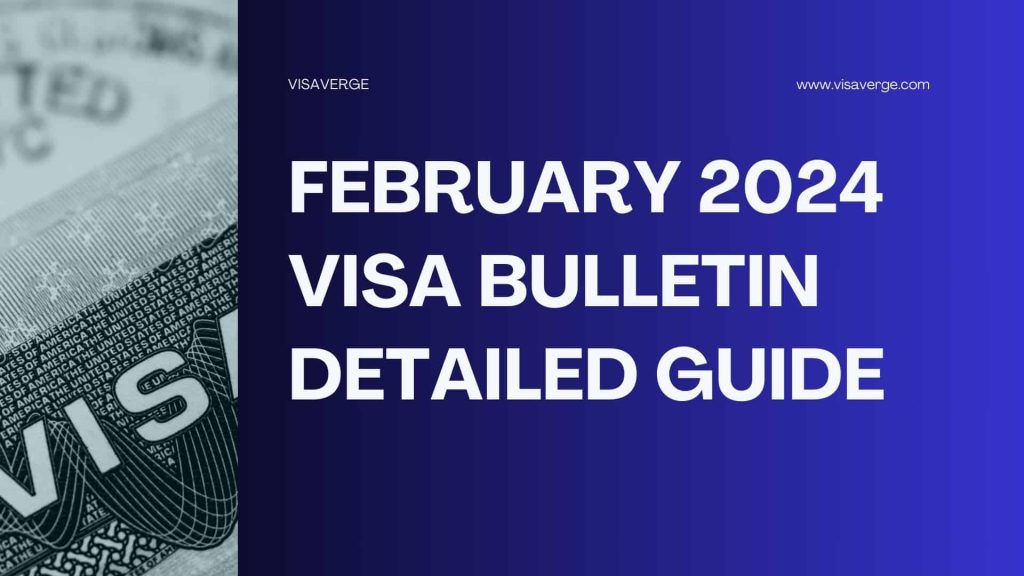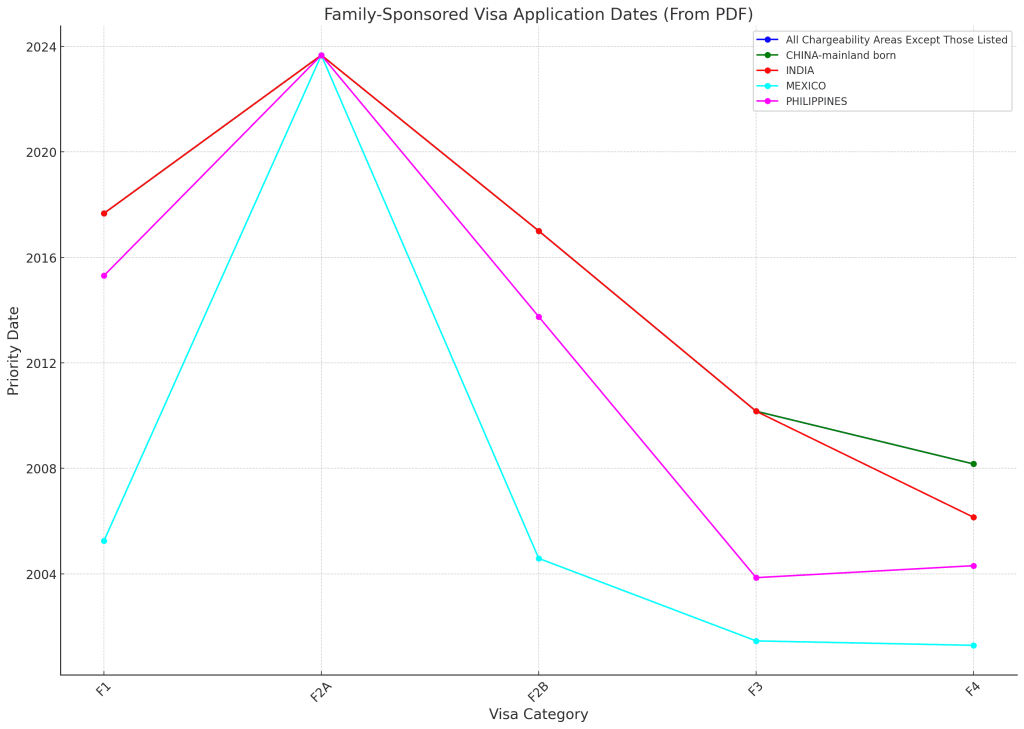The U.S. Department of State’s February 2024 Visa Bulletin has been officially published, providing vital data on the issuance and filing of immigrant visas. This guide is structured to offer a detailed analysis of the bulletin, aiding individuals in deciphering their position in the queue for a U.S. green card.
Understanding the Visa Bulletin: The Fundamentals

Immigrant visa applicants and their sponsors eagerly await the monthly Visa Bulletin to understand the availability and progression of visa numbers. The bulletin is separated into two primary sections:
- Final Action Dates: Dates when visas can potentially be granted.
- Dates for Filing Applications: Earliest dates when applicants are advised to prepare and submit documents.
The complexity of the bulletin arises from its function in determining when an individual can legally apply for permanent residency (green card) in the United States. It revolves around ‘priority dates,’ which are issued to applicants when their sponsorship petitions are filed. To interpret the bulletin accurately, individuals are encouraged to visit USCIS’s dedicated Visa Bulletin page.
February 2024 Visa Bulletin:
Family-Sponsored Visas: A Closer Look
The family-sponsored section of the bulletin is divided into distinct preferences, each with allocated visa numbers:
| Visa | All Chargeability Areas Except Those Listed | CHINA-mainland born | INDIA | MEXICO | PHILIPPINES |
|---|---|---|---|---|---|
| F1 | 01JAN15 | 01JAN15 | 01JAN15 | 01MAY01 | 01MAR12 |
| F2A | 08FEB20 | 08FEB20 | 08FEB20 | 01FEB20 | 08FEB20 |
| F2B | 01OCT15 | 01OCT15 | 01OCT15 | 22OCT03 | 22OCT11 |
| F3 | 22APR09 | 22APR09 | 22APR09 | 08SEP98 | 08JUN02 |
| F4 | 22MAY07 | 22MAY07 | 15NOV05 | 15SEP00 | 15OCT02 |
First Preference (F1): Unmarried Sons and Daughters of U.S. Citizens
This category’s final action date varies, indicating the priority date of the first applicant unable to receive a visa number. For February 2024, applicants from most countries with a priority date earlier than January 1, 2015, are considered current. Notably, the filing date has moved to September 1, 2017, indicating that applicants with priority dates before this date should initiate document preparation.
| Family Sponsored | All Chargeability Areas Except Those Listed | CHINA-mainland born | INDIA | MEXICO | PHILIPPINES |
|---|---|---|---|---|---|
| F1 | 01SEP17 | 01SEP17 | 01SEP17 | 01APR05 | 22APR15 |
| F2A | 01SEP23 | 01SEP23 | 01SEP23 | 01SEP23 | 01SEP23 |
| F2B | 01JAN17 | 01JAN17 | 01JAN17 | 01AUG04 | 01OCT13 |
| F3 | 01MAR10 | 01MAR10 | 01MAR10 | 15JUN01 | 08NOV03 |
| F4 | 01MAR08 | 01MAR08 | 22FEB06 | 15APR01 | 22APR04 |
Second Preference (F2A and F2B): Spouses, Children, and Unmarried Sons and Daughters of Permanent Residents
- F2A category has a final action date of February 8, 2020, exempt from per-country limits for most countries. It signifies a small movement, showing slight progression in visa availability.
- F2B category caters to unmarried sons and daughters (21 years of age or older) of permanent residents. As of February 2024, those with priority dates earlier than October 1, 2015, for most countries, can expect visa availability.
Third Preference (F3): Married Sons and Daughters of U.S. Citizens
With a final action date of April 22, 2009, for most countries, progress in this category is slow. Applicants should consult the bulletin to determine if their priority date is current or if they fall within the filing date of March 1, 2010.
Fourth Preference (F4): Brothers and Sisters of Adult U.S. Citizens
Being one of the more backlogged categories, as of February 2024, the final action date for most applicants is May 22, 2007. There’s a considerable wait for siblings of U.S. citizens, particularly from countries like Mexico and the Philippines, which face longer backlogs due to high demand.

Employment-Based Preferences: Insight and Analysis
The availability of employment-based visas is a cornerstone for numerous professionals worldwide. The bulletin details the cut-off dates for different employment preferences, which are essential for applicants and employers alike.
| Employment-Based Preferences | All Chargeability Areas Except Those Listed | CHINA-mainland born | INDIA | MEXICO | PHILIPPINES |
|---|---|---|---|---|---|
| 1st | C | 01JUL22 | 01SEP20 | C | C |
| 2nd | 15NOV22 | 01JAN20 | 01MAR12 | 15NOV22 | 15NOV22 |
| 3rd | 01SEP22 | 01SEP20 | 01JUL12 | 01SEP22 | 01SEP22 |
| Other Workers | 01SEP20 | 01JAN17 | 01JUL12 | 01SEP20 | 01MAY20 |
| 4th | 15MAY19 | 15MAY19 | 15MAY19 | 15MAY19 | 15MAY19 |
| Certain Religious Workers | 15MAY19 | 15MAY19 | 15MAY19 | 15MAY19 | 15MAY19 |
| 5th Unreserved | C | 15DEC15 | 01DEC20 | C | C |
| Rural (20%) | C | C | C | C | C |
| High Unemployment (10%) | C | C | C | C | C |
| Infrastructure (2%) | C | C | C | C | C |
First Preference (EB-1): Priority Workers
This category remains current for most countries, yet backlogs persist for China and India. Applicants from China must have a priority date earlier than July 1, 2022, and for India, it is September 1, 2020.
Second Preference (EB-2): Professionals Holding Advanced Degrees or Persons of Exceptional Ability
While most countries are currently processing, China’s cut-off date is January 1, 2020, and India’s is March 1, 2012, reflecting the high volume of applicants and resultant backlog.
Third Preference (EB-3): Skilled Workers, Professionals, and Other Workers
Similar to the EB-2 category, the EB-3 final action dates are current except for China (September 1, 2020) and India (July 1, 2012), emphasizing the demand from these countries.
Other Notable Categories
| Employment-Based Categories | All Chargeability Areas Except Those Listed | CHINA-mainland born | INDIA | MEXICO | PHILIPPINES |
|---|---|---|---|---|---|
| 1st | C | 01JAN23 | 01JAN21 | C | C |
| 2nd | 15FEB23 | 01JUN20 | 15MAY12 | 15FEB23 | 15FEB23 |
| 3rd | 01FEB23 | 01JUL21 | 01AUG12 | 01FEB23 | 01JAN23 |
| Other Workers | 15DEC20 | 01JUN17 | 01AUG12 | 15DEC20 | 15MAY20 |
| 4th | 01SEP19 | 01SEP19 | 01SEP19 | 01SEP19 | 01SEP19 |
| Certain Religious Workers | 01SEP19 | 01SEP19 | 01SEP19 | 01SEP19 | 01SEP19 |
| 5th Unreserved | C | 01JAN17 | 01APR22 | C | C |
| 5th Set Aside: Rural (20%) | C | C | C | C | C |
| 5th Set Aside: High Unemployment (10%) | C | C | C | C | C |
| 5th Set Aside: Infrastructure (2%) | C | C | C | C | C |
The bulletin also covers other worker’s visas, certain special immigrants, and employment creation visas, each with its specific final action dates and caveats.
Diversity Visa (DV) Updates
The DV category offers up to 55,000 visas annually, promoting diversity in U.S. immigration. The February bulletin specifies regional allocations and cut-offs, with 26,500 for Africa, 5,500 for Asia, and other quotas for Europe, Oceania, and the Americas.
Conclusion
Analyzing the February 2024 Visa Bulletin reveals the intricacies of U.S. immigration law and the dynamic nature of visa availability. Both family-sponsored and employment-based visas show progression, although backlogs continue for certain countries and categories.
Given the complexities of the U.S. immigration system, it’s prudent for prospective immigrants to stay abreast of changes in the Visa Bulletin and seek guidance when necessary. The U.S. Department of State’s Bureau of Consular Affairs website serves as a valuable resource for official information and updates.
Remember that immigration law is perpetually evolving, and it’s crucial to stay informed about policy changes or legislative updates that may impact visa processing and availability. For more personalized guidance, consulting with an immigration attorney or accredited representative is advisable.












